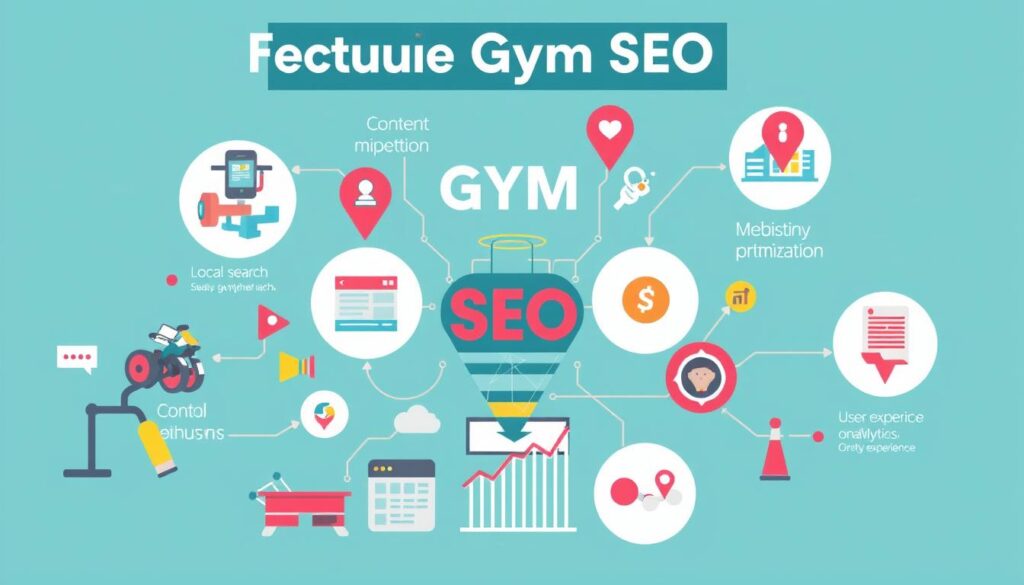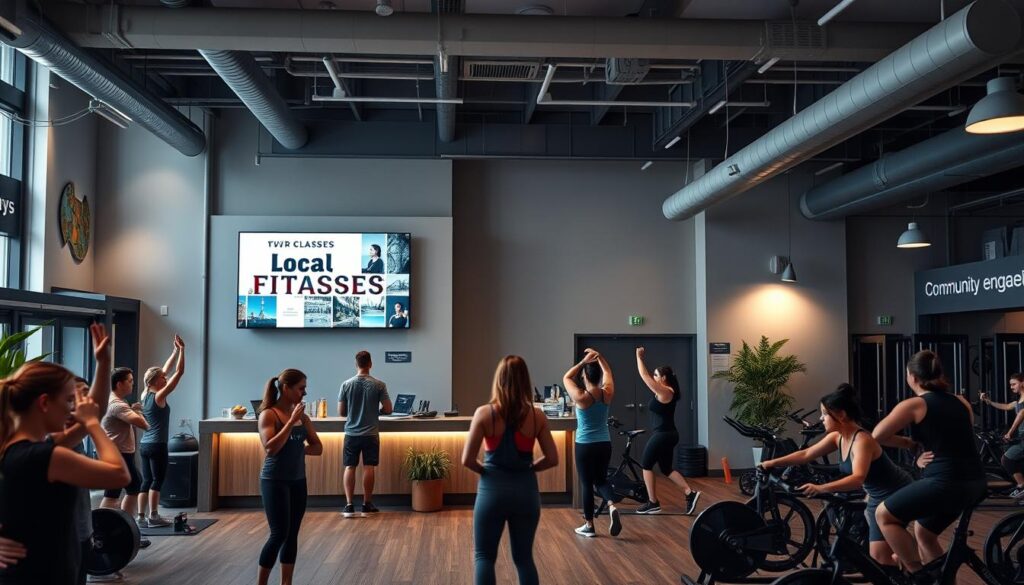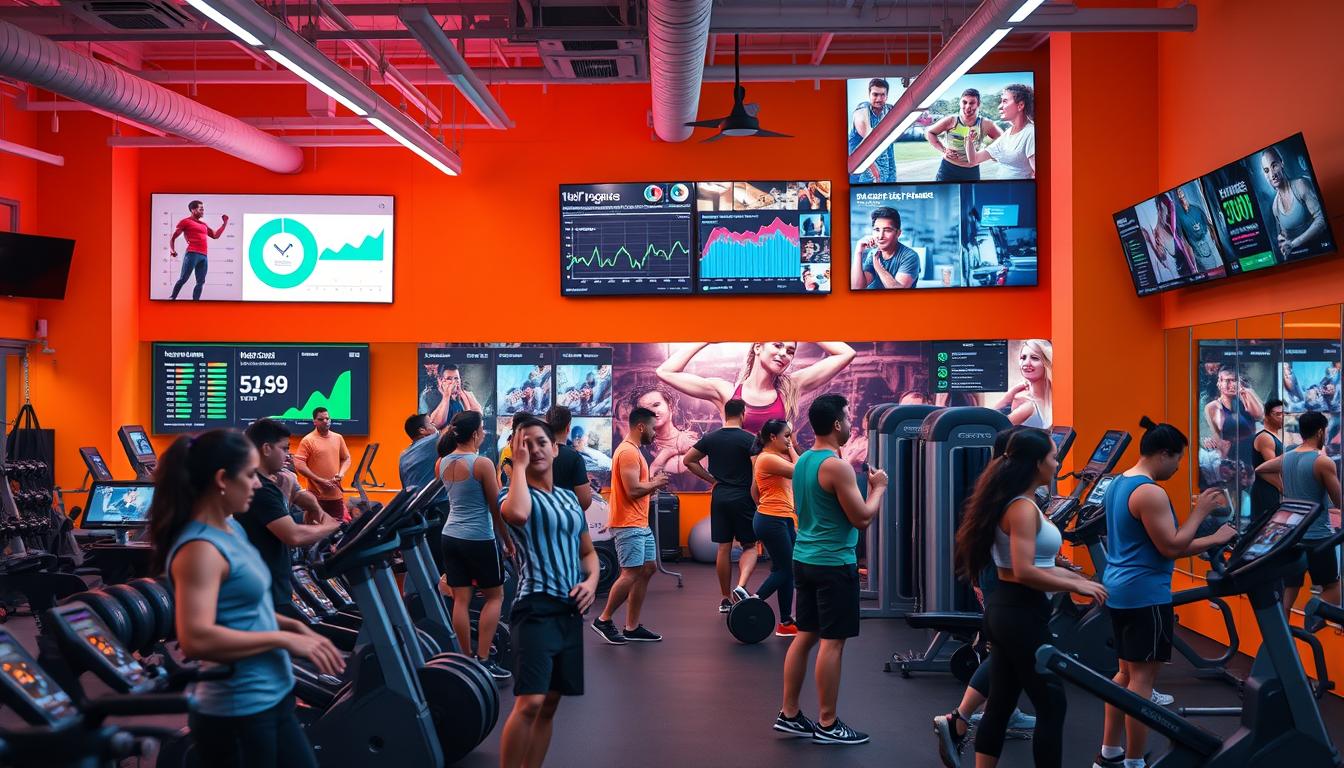Ever wondered why some gyms are always full while others can’t get new members? SEO might be the key. In today’s competitive fitness world, good gym SEO is crucial. With most web pages unseen on Google, a strong online presence is vital.
By using the right keywords, gyms can attract more visitors. These visitors can then become loyal members. This shows how important gym online marketing is for growth.
Most people look for local gyms online before joining. This makes SEO for fitness centers even more urgent. This article explores how SEO can boost your gym’s visibility and grow your membership. Want to improve your gym’s online presence? SEO experts like Revenue Boomers can help unlock your site’s full potential.
Key Takeaways
- Over 90% of web pages remain unseen, making SEO vital.
- The majority of potential gym members search online before deciding.
- Targeted keywords significantly affect membership acquisition.
- Mobile-friendly sites can enhance conversion rates.
- Regularly updated high-quality content boosts SERPs ranking.
Understanding the Importance of SEO for Gyms
The fitness world is full of gyms, all vying for attention. It’s crucial for gyms to boost their online presence. When people search for “gyms in [location],” they find many options. This makes it key for gyms to stand out with strong SEO.
The Competitive Landscape of the Fitness Industry
In the changing fitness world, being found online is key to getting new members. Half of mobile searches look for local businesses, and 60% of Google users search for nearby services. Gyms need to focus on improving their website rankings to attract this audience. Using local keywords and refining content can greatly improve a gym’s online presence.
Linking to trusted sources also boosts authority and credibility. It makes the gym seem welcoming and trustworthy.
How SEO Can Elevate Your Gym’s Visibility
Good SEO is vital for more people to find your gym. Using keywords that match your target audience brings in more visitors. Optimizing content for different search needs makes your gym the go-to choice for potential members.
By focusing on user experience and mobile-friendly design, gyms meet the needs of today’s mobile searchers. This ensures a smooth and satisfying experience for everyone.
Does SEO Work For Gyms: Analyzing Its Effectiveness
Looking into gym SEO effectiveness means checking out how gyms have grown thanks to SEO. Many gyms have seen a big jump in members by getting better online. This shows the power of SEO in the fitness world.
Real-World Examples of SEO Success in Fitness Centers
Many gyms have used local SEO and seen great results. With 63,000 Google searches every second, being on the first page is key. SEO helps gyms stand out and build trust.
For instance, a gym that improved its website and local search got more people coming in. Good reviews on Google Business Profile helped them rank higher.
Comparison with Traditional Marketing Strategies
SEO is a smart choice for gyms instead of expensive ads. Ads might work fast, but SEO keeps bringing in people over time. Digital marketing is steady and focused, unlike offline ads.
With 88% of people checking out local stores soon after searching, local SEO is crucial. Using tools like Google Analytics helps gyms get better at SEO.
| Marketing Strategy | Benefits | Drawbacks |
|---|---|---|
| SEO | Cost-effective, long-term benefits, enhances brand authority | Requires ongoing effort and expertise |
| Traditional Advertising | Immediate visibility, broad reach | Often expensive, less targeted audience |
| Hybrid Approach | Combines strengths of both | Can lead to overextension of budget |
In short, good SEO can really help gyms grow. It’s better than old-school marketing. For more on SEO for gyms, check out this guide.
The Key Components of Effective Gym SEO
SEO for gyms needs a mix of on-page, off-page, and technical steps. Each part is key to getting more visibility and drawing in new members. By using these strategies, gyms can climb the search rankings, boost their online image, and grow their member base.
On-Page SEO Strategies: Optimization Techniques
On-page SEO for gyms means making website parts better for search engines. This includes:
- Title tags: Using main keywords about gym services.
- Meta descriptions: Writing catchy summaries to get more clicks.
- Header tags: Organizing content for easy reading and SEO.
- High-quality content: Creating gym content that speaks to the audience.
It’s important to update content often and make sure it meets what users are looking for.
Off-Page SEO: Building Authority and Trust
Off-page SEO helps build trust and credibility. Consider these strategies:
- Gaining backlinks for gyms: Getting links from trusted health sites boosts authority.
- Guest posting: Writing for popular fitness blogs can increase traffic and brand awareness.
- Leveraging social media: Engaging and sharing valuable content can draw users to your gym.
- Encouraging client reviews: Positive feedback shows reliability and attracts new members.
These off-page tactics not only attract users but also help improve search rankings.
Technical SEO: Backend Improvements for Better Crawling
Technical SEO for gyms focuses on backend improvements. Key areas include:
- Website crawlability: Making the site easy for search engines to access and analyze.
- Gym site speed: Improving loading times for better user experience and search engine satisfaction.
- Mobile-friendliness: Ensuring the site works well on all devices.
- XML sitemaps: Helping search engines index website content better.
Improving these technical aspects can make the website easier to crawl and provide a better user experience.

| SEO Component | Focus Areas | Benefits |
|---|---|---|
| On-Page SEO | Keyword integration, content quality | Enhances rankings, attracts traffic |
| Off-Page SEO | Backlinks, social engagement | Builds authority, improves reputation |
| Technical SEO | Site speed, crawlability | Enhances user experience, boosts performance |
Local SEO for Gyms: Capturing Your Target Audience
Local SEO for gyms is key to attracting people looking for fitness near them. It’s important to understand what people are searching for locally. Many use search engines to find gyms in their area. This means gyms can get more visible on Google by optimizing for these searches.
Understanding Local Search Intent for Fitness
People searching for gyms want to know things like location and services. By using local keywords, gyms can show up more in search results. This makes it easier for people to find them. It also helps gyms get more leads and members.
Using local keywords well means more people will check out different gyms. This is good for both the gym and the potential member.
Creating and Optimizing Your Google My Business Profile
Optimizing GMB for gyms is a big deal in local SEO. A good Google My Business profile gives users important details like hours and address. It also has links to your website or social media.
Keeping this profile up to date is important. Managing your GMB listing well can make your gym more visible on Google. This can lead to more people visiting and joining.

Adding photos and virtual tours can make your gym more appealing. It gives people a better idea of what to expect. Also, getting good reviews from happy clients can attract more people.
This shows how important local SEO is for gyms. Creating a great Google My Business listing is key to attracting your target audience.
Effective Keyword Research for Your Gym
Keyword research is key for a gym’s SEO success. It’s important to know the difference between various keywords. This helps attract the right audience.
Buyer keywords show someone is ready to buy fitness services. Research keywords mean they’re still looking. This helps create content that meets people at the right time.
Identifying Buyer and Research Keywords
Good keyword research for gyms targets the right audience. Buyer keywords show interest and lead to new members. Research keywords help find what people want before they buy.
Keywords like “fitness classes,” “gym near me,” and “personal trainer” attract new clients.
Utilizing Tools like Google Keyword Planner
Using tools for gym keyword research is crucial. The Google Keyword Planner for gyms shows search volume and competition. This helps decide which keywords to target.
Platforms like SEMrush offer more insights. They help track metrics like cost per click and keyword difficulty. Long-tail keywords attract specific traffic, making your SEO better.
Adding keywords to titles, metas, and content boosts SEO. Using keywords in image names and ALT text helps search engines find you. With 73% of clicks in 2022 coming from organic search, optimizing keywords is key.
Measuring and Analyzing SEO Performance
It’s crucial for gyms to know how to measure and analyze SEO performance. They can use tools like Google Analytics to track their website’s performance. This helps them see how well their marketing strategies are working.
Using Google Analytics to Track User Behavior
Google Analytics is a key tool for tracking important metrics. Gyms can use it to see how many people visit their site from search results. They can also check how many people click on their site and how many stay to explore.
These numbers tell gyms how well their SEO is doing. For example:
| Metric | Description |
|---|---|
| Organic Traffic | Visitors arriving through search results, showcasing the effectiveness of SEO efforts. |
| Keyword Rankings | Position of the gym’s website for targeted keywords, indicating visibility in SERP rankings for gyms. |
| Click-Through Rate (CTR) | Percentage of searchers clicking on the gym’s link after seeing it in search results. |
| Bounce Rate | Percentage of visitors leaving the site after viewing only one page, indicating user engagement levels. |
| Conversion Rate | Percentage of visitors completing desired actions, reflecting the success of SEO in attracting customers. |
Understanding SERP Rankings and Adjusting Strategies
By analyzing SERP rankings, gyms can see how well they’re doing in search results. This helps them make changes to their marketing. Tools like SEMRush and Moz help gyms find areas to improve.
Regularly checking these metrics helps gyms stay on top of trends. Using Google Trends keeps them informed about what people are searching for. This helps them fine-tune their SEO and succeed in the competitive fitness market.
Conclusion
In today’s gym world, a strong gym SEO strategy is a must. This article showed how SEO is key for more visibility and attracting new members. By using local SEO tactics, like optimizing Google My Business and creating class pages, gym owners can boost their success.
Adding engaging visuals and detailed info improves user experience and search engine rankings. This mix of local keywords and easy navigation boosts your gym’s online presence. It helps meet the needs of potential clients.
Gym owners looking to grow should consider partnering with SEO experts like Revenue Boomers. They offer valuable insights and tools for SEO success. Remember, staying up-to-date with digital trends is crucial for success in a competitive market. For more tips, check out this detailed guide on gym SEO.






